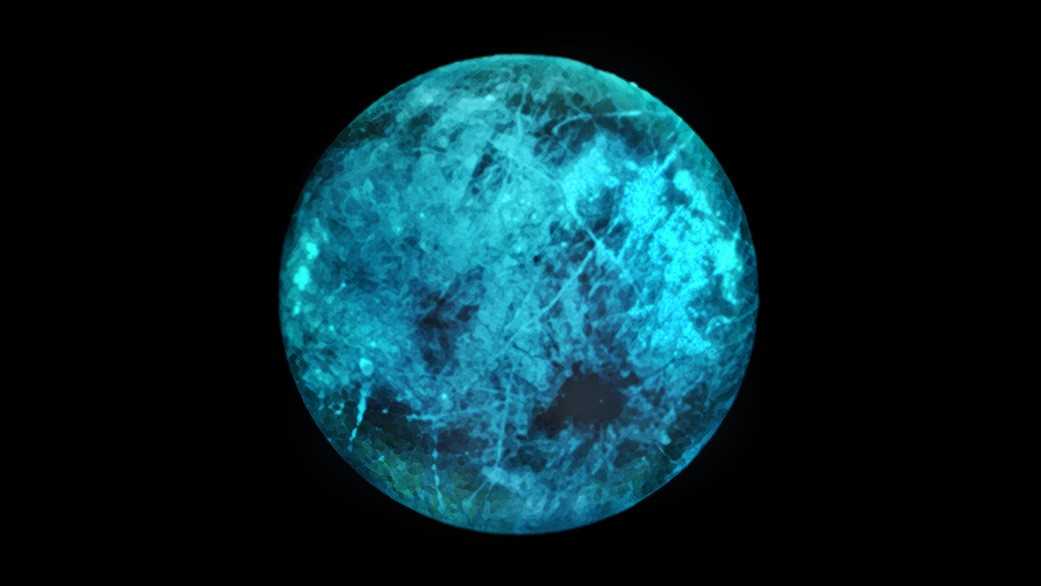Jupiter's moon Europa is a fascinating celestial body that has captivated astronomers and space enthusiasts for decades. One of the most stunning features of Europa is its beautiful glow, which is caused by the moon's interaction with Jupiter's magnetic field.
Europa is the sixth largest moon in the solar system and is roughly the same size as Earth's moon. It is known for its icy surface, which is believed to cover a vast ocean beneath. This ocean is considered to be one of the most promising places in the solar system to find extraterrestrial life.
However, Europa's glow is a remarkable feature that is often overlooked. The moon's surface is bombarded by high-energy particles that are trapped in Jupiter's magnetic field. These particles interact with the moon's surface and cause it to glow in a phenomenon known as aurora.
Aurora is a natural light display that occurs in the polar regions of planets, including Earth. It is caused by the interaction between charged particles from the sun and a planet's magnetic field. The same phenomenon occurs on Europa, but it is much more spectacular.
Europa's glow is blue-green in color, and it covers the entire surface of the moon. The glow is most intense in the trailing hemisphere, which faces away from Jupiter. This is because the particles that cause the glow are swept back by Jupiter's magnetic field, creating a tail behind Europa.
The glow on Europa is not just beautiful to look at; it also provides valuable information about the moon's environment. Scientists use the intensity and color of the glow to study the composition of Europa's surface and the nature of the charged particles that interact with it.
In addition to its glow, Europa is also known for its unique geology. The moon's icy surface is covered in cracks and ridges, which are believed to be caused by the tidal forces exerted by Jupiter. These forces cause the moon's surface to stretch and compress, creating the distinctive features that we see today.
Europa's potential for harboring life has also made it a target for future exploration. Several missions have been proposed to study the moon in more detail, including the Europa Clipper mission, which is scheduled to launch in the 2020s.
| Fact | Description |
|---|---|
| Discovery | Discovered by Galileo Galilei in 1610 |
| Location | Fourth-largest moon of Jupiter |
| Size | 3,122 kilometers (1,940 miles) in diameter |
| Composition | Mostly composed of silicate rock and a water-ice crust |
| Atmosphere | Europa has a very thin atmosphere, composed mainly of oxygen |
| Surface features | Europa's surface is covered in a layer of ice that is riddled with cracks and ridges. It is believed that this ice is floating on top of an ocean of liquid water |
| Magnetic field | Europa does not have its own magnetic field, but it interacts with Jupiter's magnetic field, which causes a beautiful blue-green glow on the moon's surface |
| Potential for life | Europa is considered one of the most promising places in the solar system to find extraterrestrial life due to the presence of a subsurface ocean that may contain the necessary conditions for life to exist |
| Missions | The Europa Clipper mission, scheduled to launch in the 2020s, will study Europa from orbit. There are also proposals for a lander mission to directly study the moon's surface |
| Exploration | Only one spacecraft, the Galileo mission, has visited Europa. It orbited Jupiter from 1995-2003 and conducted several flybys of Europa, providing valuable data about the moon's environment |
These are some of the most important and interesting facts about Europa. With ongoing and future missions, we can expect to learn even more about this fascinating moon and its potential for life in the solar system.
The discovery of Europa's glow has opened up new avenues of research for scientists studying the moon. By analyzing the light emitted by the glow, scientists can determine the composition of Europa's surface and the nature of the particles that cause the glow. This information is crucial for understanding the conditions on Europa and the potential for life beneath its icy crust.
One of the most exciting possibilities for life on Europa is the existence of hydrothermal vents on the ocean floor. These vents are known to support diverse ecosystems on Earth, and scientists believe that they could also exist on Europa. If life does exist on Europa, it would be a groundbreaking discovery that could shed light on the origin and evolution of life in the universe.
To explore the potential for life on Europa, several missions have been proposed to study the moon in more detail. The Europa Clipper mission, which is scheduled to launch in the 2020s, will study the moon's ocean, composition, and geology from orbit. The mission will carry a suite of scientific instruments to measure the thickness of Europa's icy crust, the depth and salinity of its ocean, and the composition of its surface.
In addition to the Europa Clipper mission, there are also proposals for a lander mission that would explore the moon's surface and search for signs of life. A lander mission would allow scientists to directly sample Europa's surface and study its geology and potential habitability.
The study of Europa and its beautiful glow is a fascinating field of research that continues to captivate scientists and space enthusiasts around the world. With new missions on the horizon, we are sure to uncover more secrets about this fascinating moon and its potential for life in the solar system.
Discover More
Most Viewed
Christmas is a season of joy, love, and traditions. And what better way to get into the holiday spirit than through timeless carols? These musical gems have been bringing people together for generations. Here’s our ranked list of the Top 10 Christmas Caro…
Read More

















